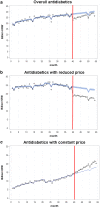Effects of a price cut reform on the cost and utilization of antidiabetic drugs in Korea: a national health insurance database study
- PMID: 29879966
- PMCID: PMC5992837
- DOI: 10.1186/s12913-018-3255-y
Effects of a price cut reform on the cost and utilization of antidiabetic drugs in Korea: a national health insurance database study
Abstract
Background: Despite the potential widespread application and a significant need, the policy effectiveness of prescribed medications price controls has not been studied extensively. We aimed to explore the effects of a price cut introduced in April 1st of 2012 on the cost and utilization of antidiabetics in South Korea.
Methods: We identified approximately four million outpatients who filed at least one diabetes-related claim during the index period (January 2010 to December 2012) using the National Health Insurance claims data. We performed interrupted time series analyses for cost and utilization of "overall," "reduced price," and "constant price" antidiabetics between January 2009 and June 2013, and measured the growth rate for incidents of medical and surgical procedures for diabetes-induced complications.
Results: The segmented regression suggests that spending on overall and reduced price antidiabetics would drop by 6 and 23%, respectively; spending on constant price antidiabetics would rise by 16% in a year after the new pricing compared to if the policy were not in existence. There were a few immediate changes in utilization, and its trend indicated a significant decrease in reduced price antidiabetics and an increase in constant price antidiabetics. Incidents of medical and surgical procedures relating to diabetic complications were unaffected.
Conclusions: The Korean price cut program contained costs by immediately reducing the cost of pharmaceuticals without any major signals associated with compromised clinical conditions in diabetic patients.
Keywords: Antidiabetics; Direct price control; Pharmaceutical costs; Pharmaceutical utilization; Price cut.
Conflict of interest statement
Competing interests
The authors declare that they have no competing interests.
Publisher’s Note
Springer Nature remains neutral with regard to jurisdictional claims in published maps and institutional affiliations.
Figures
Similar articles
-
Effects of drug price reduction and prescribing restrictions on expenditures and utilisation of antihypertensive drugs in Korea.BMJ Open. 2015 Jul 15;5(7):e006940. doi: 10.1136/bmjopen-2014-006940. BMJ Open. 2015. PMID: 26179644 Free PMC article.
-
Do cost containment policies save money and influence physicians' prescribing behavior? Lessons from South Korea's drug policy for diabetes medication.Int J Qual Health Care. 2019 Mar 1;31(2):96-102. doi: 10.1093/intqhc/mzy114. Int J Qual Health Care. 2019. PMID: 29788203
-
Easy cuts, easy rebound: Drug expenditures with massive price cuts in Korea.Health Policy. 2019 Apr;123(4):388-392. doi: 10.1016/j.healthpol.2018.11.002. Epub 2018 Nov 20. Health Policy. 2019. PMID: 30503763
-
Repaglinide : a pharmacoeconomic review of its use in type 2 diabetes mellitus.Pharmacoeconomics. 2004;22(6):389-411. doi: 10.2165/00019053-200422060-00005. Pharmacoeconomics. 2004. PMID: 15099124 Review.
-
Comparative approaches to pharmaceutical price regulation in the European Union.Croat Med J. 2002 Aug;43(4):453-61. Croat Med J. 2002. PMID: 12187524 Review.
Cited by
-
Impact of medical insurance access negotiation on the utilization of innovative anticancer drugs in China: an interrupted time series analysis.BMC Health Serv Res. 2024 Jan 17;24(1):90. doi: 10.1186/s12913-023-10393-y. BMC Health Serv Res. 2024. PMID: 38233857 Free PMC article.
-
A systematic review of pharmaceutical price mark-up practice and its implementation.Explor Res Clin Soc Pharm. 2021 May 6;2:100020. doi: 10.1016/j.rcsop.2021.100020. eCollection 2021 Jun. Explor Res Clin Soc Pharm. 2021. PMID: 35481119 Free PMC article. Review.
-
Effect of China national centralized drug procurement policy on anticoagulation selection and hemorrhage events in patients with AF in Suining.Front Pharmacol. 2024 Feb 20;15:1365142. doi: 10.3389/fphar.2024.1365142. eCollection 2024. Front Pharmacol. 2024. PMID: 38444941 Free PMC article.
-
Did the universal zero-markup drug policy lower healthcare expenditures? Evidence from Changde, China.BMC Health Serv Res. 2021 Nov 6;21(1):1205. doi: 10.1186/s12913-021-07211-8. BMC Health Serv Res. 2021. PMID: 34742310 Free PMC article.
References
-
- Mossialos E, Mrazek M, Walley T. Regulating pharmaceuticals in Europe: striving for efficiency, equity and quality. Maidenhead: Open University Press; 2004.
-
- OECD: Pharmaceutical pricing policies in a global market. Paris: OECD (Organisation for Economic Co-operation and Development); 2008.
Publication types
MeSH terms
Substances
Grants and funding
LinkOut - more resources
Full Text Sources
Other Literature Sources
Medical
Miscellaneous


